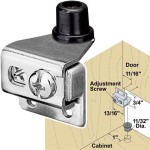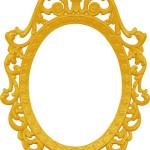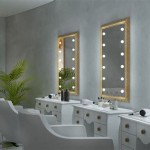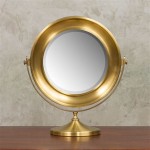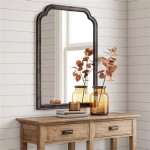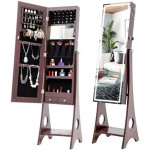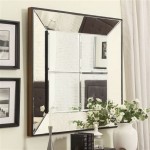How To Tighten A Tilting Bathroom Mirror
Tilting bathroom mirrors offer convenience for users of varying heights and preferences. However, over time, the tilting mechanism can loosen, causing the mirror to droop or become unstable. This article provides a comprehensive guide on how to tighten a tilting bathroom mirror, restoring its functionality and stability.
Identifying the Type of Tilting Mechanism
Before attempting any adjustments, it's crucial to identify the type of tilting mechanism the mirror employs. Two common types exist:
- Set Screw Mechanism: This type uses one or two screws on the sides or bottom of the mirror frame to control the tension. These screws interact with a spring-loaded mechanism or a friction plate.
- Ball and Socket Joint: This mechanism utilizes a ball-and-socket joint inside the mirror frame. Tightening typically involves adjusting a nut or screw located behind the mirror glass.
Tools Required
Gathering the necessary tools beforehand streamlines the tightening process. The tools required will depend on the tilting mechanism:
- Screwdriver: A Phillips or flathead screwdriver, depending on the screw type used in the set screw mechanism. Ensure the screwdriver is the correct size to prevent stripping the screw head.
- Allen Wrench/Hex Key: Some set screws utilize Allen wrenches. Select the correct size for the set screw.
- Pliers: May be required for gripping and turning nuts or screws, particularly with ball-and-socket joints.
- Flashlight: Useful for illuminating the area behind the mirror, especially when working with ball-and-socket joints.
- Suction Cups: These can assist in holding the mirror steady while making adjustments.
Tightening a Set Screw Mechanism
Tightening a set screw mechanism is generally straightforward:
- Locate the Set Screws: Look for screws on the sides or bottom of the mirror frame. They are usually located near the hinges or pivoting points.
- Test the Tension: Try tilting the mirror. This helps pinpoint which screw(s) require adjustment.
- Tighten the Screws: Using the appropriate screwdriver or Allen wrench, carefully tighten the set screws. Turn them clockwise in small increments, testing the mirror's tilt after each adjustment.
- Avoid Overtightening: Overtightening can damage the mechanism or the mirror frame. Stop tightening when the mirror holds its position securely.
Tightening a Ball and Socket Joint
Tightening a ball and socket joint is often more complex and may require accessing the back of the mirror:
- Prepare the Area: Cover the sink and countertop to protect them from scratches or dropped tools.
- Carefully Remove the Mirror: If the mirror is attached with clips, gently pry them open. If it's glued to the wall, carefully pry it loose using putty knives and shims. If unsure, consult professional help. Having another person assist makes this step safer.
- Locate the Adjusting Nut/Screw: Once the mirror is removed (or accessible depending on the mirror's design), locate the nut or screw at the base of the ball and socket joint.
- Tighten the Nut/Screw: Use pliers or an appropriate wrench to carefully tighten the nut or screw. Small adjustments and frequent testing are key.
- Reinstall the Mirror: Carefully reattach the mirror to the wall, reversing the removal process.
Troubleshooting
If the mirror still tilts loosely after tightening the mechanism, consider these troubleshooting steps:
- Worn-out Mechanism: If the mechanism itself is worn out, tightening may not be effective. Replacement of the entire tilting mechanism may be necessary.
- Stripped Screws: Stripped screws prevent effective tightening. Consider replacing them with screws of the same size and type. Ensure you're using the correct screwdriver size to avoid further stripping.
- Damaged Ball and Socket: A damaged ball and socket joint may require professional repair or replacement of the entire mirror assembly.
Maintaining Your Tilting Mirror
Regular maintenance can help prevent future loosening and ensure the longevity of your tilting bathroom mirror:
- Periodic Checks: Periodically check the tightness of the tilting mechanism and make minor adjustments as needed.
- Avoid Forceful Adjustments: Avoid using excessive force when adjusting the mirror's angle. Gentle movements prevent strain on the mechanism.
- Clean the Mechanism: Dust and debris can interfere with the smooth operation of the tilting mechanism. Regularly clean the area around the mechanism with a soft cloth.
Safety Precautions
Prioritize safety when working with tools and potentially heavy objects like bathroom mirrors:
- Eye Protection: Wear safety glasses to protect your eyes from dust and debris.
- Gloves: Gloves provide a better grip and protect your hands.
- Proper Lighting: Ensure adequate lighting to clearly see the working area and prevent accidents.
- Professional Assistance: If you are uncomfortable working with tools or unsure about any step, seek assistance from a qualified handyman or professional.

Square Brushed Gold Pivot Mirror Hardware Tilting Anchors Hamilton Hills

Pivot Tilting Bathroom Mirror Fix How To A Loose Easy

Moen Glenshire 26 In X 22 Frameless Pivoting Wall Mirror Spot Resist Brushed Nickel Dn2692bn The Home Depot

Have A Question About Moen Banbury 23 In W X 26 H Oval Frameless Tilt Wall Bathroom Vanity Mirror Brushed Nickel Pg 3 The Home Depot

Allied Brass Shadwell 21 In X 3 4 Antique Copper Arch Frameless Tilting Bathroom Vanity Mirror The Mirrors Department At Com

Gold Pivot Mirror Rectangle Bathroom Mirrors For Wall 24 36 Inch Brightify Tilt With Rounded Rectangular Frame Horizontal Or Vertical Mounted Tilting Living Room Com

Sensio Pearl Non Illuminated Bathroom Mirror With Tilting Wall Bracket Bevelled 500 X 500mm Toolstation

Round Broe Pivot Mirror Hardware Tilting Anchors Hamilton Hills

Moon Mirror 20 X 28 Black Metal Framed Pivot Rectangle Bathroom In Stainless Steel Tilting Rounded Rectangular Vanity For Wall Mounted Hangs Vertical Swiss Cycles

Supply Oval Rotating Mirror Tilting Bathroom Vanity Whole Factory Foshan Leijie Kitchen And Co Ltd

